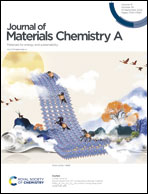Modeling of the cathodic and anodic polarization curves of metals and alloys at an electronic level†
Abstract
Accurate prediction of the cathodic and anodic polarization curves of metals and alloys remains a big challenge in the framework of density functional theory (DFT). Here, we propose a new strategy to simulate the polarization curves of Fe–Cr alloys by considering both the thermodynamics and kinetics of corrosion processes. For the anodic dissolution process, the electrode potential of the anode increases when more electrons are transferred to the cathode, and the resulting anodic activation energy caused by charge transfer shows an exponential relation with the anodic corrosion current. For the cathode hydrogen evolution reactions, the electrode potential decreases when more electrons are gained from the anode, and the cathode corrosion current increases with the increase in the cathodic activation energy. Based on our method, the determined Tafel slope (118.7 mV dec−1) shows an excellent agreement with the theoretical calculations obtained by the Tafel mechanism of the hydrogen reduction reaction (118 mV dec−1). Our proposed method, which largely relies on the DFT calculations, could be helpful for the design of many metals and alloys with better corrosion resistance.



 Please wait while we load your content...
Please wait while we load your content...